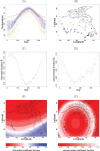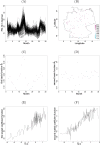Interpretable, predictive spatio-temporal models via enhanced pairwise directions estimation
- PMID: 37808617
- PMCID: PMC10557555
- DOI: 10.1080/02664763.2022.2147150
Interpretable, predictive spatio-temporal models via enhanced pairwise directions estimation
Abstract
This article concerns predictive modeling for spatio-temporal data as well as model interpretation using data information in space and time. We develop a novel approach based on supervised dimension reduction for such data in order to capture nonlinear mean structures without requiring a prespecified parametric model. In addition to prediction as a common interest, this approach emphasizes the exploration of geometric information from the data. The method of Pairwise Directions Estimation (PDE) is implemented in our approach as a data-driven function searching for spatial patterns and temporal trends. The benefit of using geometric information from the method of PDE is highlighted, which aids effectively in exploring data structures. We further enhance PDE, referring to it as PDE+, by incorporating kriging to estimate the random effects not explained in the mean functions. Our proposal can not only increase prediction accuracy but also improve the interpretation for modeling. Two simulation examples are conducted and comparisons are made with several existing methods. The results demonstrate that the proposed PDE+ method is very useful for exploring and interpreting the patterns and trends for spatio-temporal data. Illustrative applications to two real datasets are also presented.
Keywords: Covariates; dimension reduction; kriging; semi-parametric models; spatio-temporal data; visualization.
© 2022 Informa UK Limited, trading as Taylor & Francis Group.
Conflict of interest statement
No potential conflict of interest was reported by the author(s).
Figures




References
-
- Bakar K.S. and Sahu S.K., sptimer: spatio-temporal bayesian modelling using R, J. Stat. Softw. 63 (2015), pp. 1–32.
-
- Braud I. and Obled C., On the use of empirical orthogonal function (EOF) analysis in the simulation of random fields, Stoch. Hydrol. Hydraul. 5 (1991), pp. 125–134.
-
- Coudret R., Girard S., and Saracco J., A new sliced inverse regression method for multivariate response, Comput. Stat. Data. Anal. 77 (2014), pp. 285–299.
-
- Cressie N., Statistics for Spatial Data, John Wiley & Sons, Hoboken, 2015.
LinkOut - more resources
Full Text Sources
